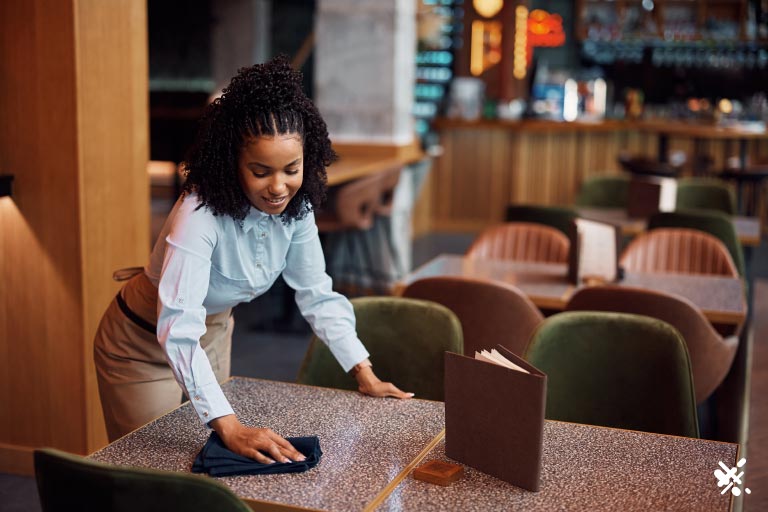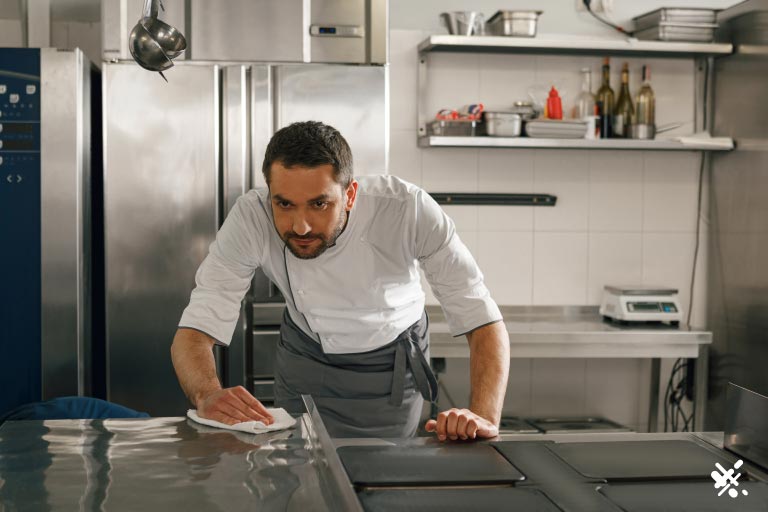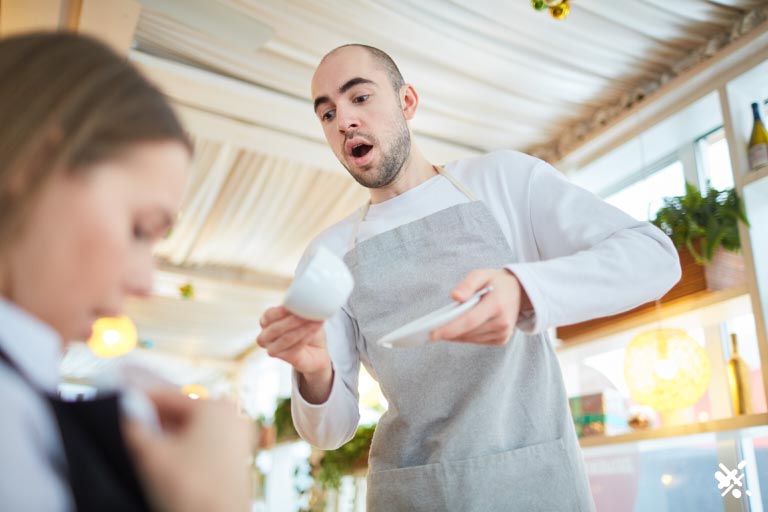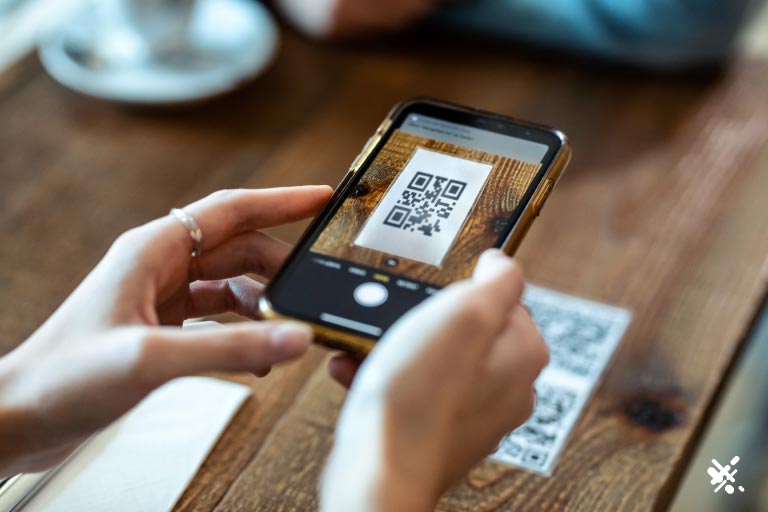The food business is difficult. But for some entrepreneurs, it’s a lifetime dream—a dream that has several inherent liabilities. It makes sense that potential risks are everpresent. After all, you are working with fire, knives, and perishable products. Thankfully there are plenty of ways to address risks and restaurant liabilities in the industry.
Separate Yourself from Your Restaurant
Before discussing how to limit restaurant liabilities, let’s discuss the frontline strategy of forming a limited liability company or a C-corporation. An LLC or Limited Liability Company is a business entity separate from you and your assets. A C-corp is similar in this regard to an LLC but has better tax implications.
Either way, there’s a point to keeping your business separate from your personal life. Let’s say something goes wrong at your restaurant, and a disgruntled customer or staff member sues you. If your restaurant is a separate legal entity, they can only go after the restaurant’s assets, not your personal ones.
It is possible in certain situations for a plaintiff to sue and recover damages from a business owner’s personal assets. This typically happens when the business owner does not keep their assets and expenditures separate—e.g., having the same bank account for personal and business use or using a business credit card for personal purchases.
However, “piercing the corporate veil” is harder for lawyers if business and personal finances are kept separate. When layered, legal strategies for separating yourself from your business can become even more effective.
There are ways to maintain total anonymity, such as forming an LLC based in Wyoming. But these interesting strategies will take us beyond the scope of this purview, so consult a lawyer to learn more.

Follow Food Safety Rules and Regulations
Rules and regulations can seem onerous but often provide effective barriers against food poisoning. One of the most obvious of restaurant liabilities. The most common culprits for causing food poisoning (according to the CDC) are fish (17%), dairy (11%), chicken (9%), beef and mollusks (tied at 8%), and pork (7%). Raw vegetables and fruits are tied at 6%, and turkey is a surprisingly low 4% (gobble, gobble).
As you can see, the most common culprits are animal proteins, particularly bad seafood. Improperly stored, handled, or cooked animal products can breed bacteria, creating a culinary experience your customers won’t forget…certain pungent notes of live cultures and a certain aftertaste that is…je ne sais quoi.
All joking aside, foodborne illness outbreaks have a devastating impact. Surprisingly, food poisoning impacts one in six Americans every year. 128,000 Americans are hospitalized, and 3,000 even die from food poisoning.
The Deadly Liability of Avoiding Food Safety Rules
A 2009 salmonella outbreak in PCA peanut butter made 714 people ill and killed nine consumers. A 2011 outbreak in Cargill, Turkey, made 136 people sick, and a 2013 Foster Farms Chicken outbreak made another 634 consumers ill.
E. coli is another infamous bacterial strain facilitated by improper handling of food. A 1993 E. coli outbreak at Jack in the Box sickened 100 customers and killed 9. A 2006 outbreak at Taco Bell made 71 sick. And a 2015 outbreak at Chipotle made 55 people ill.
As you can see, some of the worst outbreaks were not from family-owned restaurants but from large food conglomerates or restaurant chains. Part of this is about scale, as these businesses serve far more consumers. But part of it is a warning that no food business is impervious to the dangers of food poisoning.
Your local board of health will have rules and regulations they ask restaurant owners to follow. These vary from county to county but may include best practices such as using color-coded cutting boards for different food products.
For instance, red cutting boards for raw beef, blue for raw fish, and green for fruits and vegetables. Chefs and line cooks will know to refrain from chopping a salad on a red cutting board or slicing a freshly prepared sandwich on a blue cutting board.
Applying these best practices can significantly reduce your liabilities by reducing the likelihood of contamination in your restaurant. And one of these best practices is to keep your kitchen constantly as clean as possible.

Keep Your Restaurant Clean
An average commercial kitchen requires daily cleaning and a deep clean at least once per week. Traditional restaurant design has favored putting the kitchen in a separate room for several decades.
Away from the eyes of diners, it’s easier to let things get messy back there. But a messy, disorganized kitchen can become a breeding ground for bacteria and an opportune zone for cross-contaminating foods.
You may be able to hide your kitchen from diners, but you cannot hide the truth forever. A customer may peek into the kitchen. A staff member might tell a friend, who tells a friend…and so on. A delivery driver might be invited back for a pickup and post an unflattering video on social media. Rather than “get caught,” you should always have clean hands. Or a clean kitchen, rather.
Dirty Restaurant Statistics
66% of consumers do not want to eat at a restaurant with bad hygiene, and 75% won’t return if there is an “incident” until the restaurant changes ownership. To put that in a little perspective, only 16% of diners would avoid returning because of slow service. In other words, cleanliness and hygiene are very important to customers in the food business.
A different survey suggested that over 82% of diners will not return to a restaurant with bad service, which shows that the service experience is important. But this particular survey also had some damning implications about restaurant cleanliness.
As many as 81% of diners will leave because of dirty bathrooms, 74% because of dirty or sticky tables, 66% because of dirty floors, 38% because of unpleasant smells, 31% for stained napkins or tablecloths, and 21% because of visible rodents or insects. And don’t even get us started on a restaurant that checks off all these boxes.
Customers understandably want to avoid signs of dirtiness in the area where they eat. And although they won’t be eating in the bathroom, it sends a message about the overall hygiene of the restaurant.
Moreover, customer perceptions are a good barometer of your potential liabilities. A messy, dirty restaurant is more likely to become ground zero for a food poisoning incident than a clean restaurant.
Keep Sick Workers Away From Food
Another significant source of restaurant liability for small business owners is their human capital. In connection to the previous topic, sick workers can also lead to food poisoning incidents. In fact, 40% of said incidents are not tied to food but to a sick worker.
The food business is already very stressful, and being short-staffed adds more stress to everyone’s plate. Then there is the fact that most Americans are living paycheck to paycheck and don’t want to miss their shift. Put these two things together, and you’ll see it’s unfortunately likely for employees to show up when sick.
Many restaurant owners are tempted to overlook signs of sickness in favor of being fully staffed. Having a good sick policy and a pool of quality, available human talent will go a long way here. Easier said than done, of course, but securing reliable kitchen and wait staff will mean that you can send sick workers home without suffering a staffing shortage.

Carry Worker’s Comp…You Have To, Anyway
But workers can cause problems other than by getting sick. One restaurant liability would be if an employee were to get injured and sue you. Restaurant injuries are fairly common. “If you can’t take the heat, get out of the kitchen,” the saying goes. Food prep involves sharp objects, high temperatures, fast work, and slippery fluids (water, oil, and grease). The potential for cuts, burns, collisions, and slips and falls is everpresent.
Most states require business owners to purchase worker’s compensation insurance. This type of insurance provides injured workers a short-term income while they recuperate from any injuries. If the injury proves to be permanently debilitating, they may qualify for something like SSDI (Social Security Disability Insurance).
Business owners are the policyholders of this type of insurance, and their premiums will go up if claims are activated, just like car insurance. As such, many business owners will attempt to do whatever they can to steer their employees away from filing a claim.
It’s a Bad Idea to Coherse an Employee Not to Use their Worker’s Comp Insurance
They may give the employee “time” to recuperate or even “paid time.” Some employers will intimidate the worker, perhaps over a plate of pasta fazool and veiled references to “the family.”
This is a bad idea (except for the pasta fazool…that sounds good). Do not attempt to deviate from worker’s compensation policies because the employee can then sue you for even more damages.
You can rely on the company that provides your workers comp policy; they have a claims team that will review claims for merit to determine whether the injury was work-related or accidental…or not.
A good worker’s compensation policy can also go to bat for you against employees attempting to milk a situation. While you don’t want to intimidate your employees or steer them away from the ethical course of action, you also don’t want to be a sucker. You want a worker’s comp policy that reviews claims thoroughly to protect you from frivolous claims.
Carry Restaurant Insurance
Speaking of insurance, general insurance policies are indispensable for mitigating the risk of potential restaurant liabilities. Without insurance, your restaurant is at risk of closing down 24/7. In addition to workers comp insurance for your staff, you will want general liability insurance, property insurance, and product insurance. If your restaurant serves alcohol, you may want extra bells and whistles like liquor liability insurance.
General liability insurance quotes tell you how much you’ll pay in premiums to protect your business from the fault of injuring others (like your customers). Here are two examples of accidents “caused” by your restaurant that can result in monetary damages:
- A customer who slips on a wet floor (even if there is signage posted) or
- A delivery driver who comes into the kitchen to pick up an order, reaches for a french fry, and gets splashed with burning oil.
As you can see, these things aren’t necessarily your fault. And yet, you can bet your bottom dollar your restaurant will get sued for them.
But wait… there’s more! Let’s say someone brings their service pitbull into the restaurant, and it bites another patron. You can be sued for that too! Or if a fight breaks out in your restaurant, like some of those crazy brawls we’ve been seeing up in Waffle House (we’re not sure why Waffle House is so wild these days).
Restaurant fights do happen. A 40-person brawl erupted at a Golden Corral over a piece of steak. Of course, with such incidents, your legal team will do their best to deflect all damages. But somehow, your business may be implicated. Liability insurance can cover that by paying out damages to victorious plaintiffs.

Product Liability Protection
Product liability claims relate to the product your business serves, which in this case, is food. Our points mentioned above about cleanliness and adherence to food safety practices are good ways to avoid product defects (e.g., poisoned food). But product liability cases will still occur.
You might typically think of product liability lawsuits relating to manufacturing or design defects. While that’s true of businesses that sell manufactured products, in your case, the product is food. Moreover, even if you avoid food contamination, there could still be problems.
What if a customer chokes on a fishbone that a chef accidentally left in a salmon burger? Or what happens if they are deathly allergic to sesame, and it just so happens that sesame oil is in their salad dressing? How about if their coffee is too hot or a distracted worker pours hot coffee on their crotch, like in the infamous McDonald’s case?
The injured party’s lawyer will try to find any way to get you to indemnify their client. If they can’t prove that your general liability insurance covers something, they may try to use the product liability angle. And in some cases (such as food poisoning), it’s already a product angle, to begin with: food poisoning fits into product liability law.
Protect Your Property
Property insurance is also important to protect your property from any potential restaurant liabiities–for instance, the restaurant, equipment, and everything else (plates, flatware, glasses). What happens if an angry patron launches into the kitchen, shattering hundreds of glasses and plates?
What happens if a dumpster fire breaks out behind your building and razes the entire restaurant? Property insurance will have you covered. Note, however, it will not cover you from someone leaving a Yelp Review that your restaurant “is” a dumpster fire.
As you might guess, fire is the most common cause of property damage in a restaurant. Annually, about 5,600 reported restaurant fires cost $116 million in property damage. 57% of these fires are caused by cooking equipment, 10% by heaters, and electrical failures cause 7%. Another 7% is caused by smoking, and 5% by willful arson.
A whopping 22% of these fires are attributable to a dirty kitchen. For example, a poorly cleaned range can have a buildup of dirt, which impedes ventilation and increases the fire risk. Obviously, implementing best practices reduces the concern for disastrous events. But they can still happen even when a restaurant adheres to best practices. Insurance can help make sure these accidents don’t shut down your business.
Liquor Liability Insurance
If your restaurant serves alcohol, you may also want liquor liability insurance. Dram Shop Laws are active in 44 states (named after 18th-century English taverns). These laws hold businesses liable for the actions of intoxicated patrons. If you think about this even briefly, you want to avoid being held accountable for anything inebriated patrons do.
Dram shop laws vary from state to state, but in many states, there is a threshold called the “obvious intoxication test.” This “test” considers whether or not an establishment should have served alcohol to a patron. If they knew that serving them more alcohol could increase the risk of danger to themselves or others, they could be held liable.
Liquor liability insurance can help pay out claims if your business is successfully sued for damages. This policy may be part of a comprehensive “restaurant policy” or added to your insurance policy as a “rider.”
Either way, if your restaurant serves alcohol, you should make sure you have it. And you should ensure you have the most comprehensive insurance policy possible to cover all possible scenarios.

Data Breaches and Diner Financial Information
You may think of your restaurant as something other than a high-tech business vulnerable to digital theft. But restaurants are a goldmine of customer information that is easily accessible. That’s because (in traditional restaurant settings), customer credit and debit cards are taken from the customer to a terminal, where the staff will process the payment.
Unscrupulous employees can steal credit or debit card information. And forgetful employees can leave terminals unlocked, allowing other employees to come along and steal card info. Sometimes servers will be part of a larger crime ring, funneling payment information to other criminals.
In an infamous 2011 incident in New York, servers used card skimmers to steal customer info and purchase luxury items. Come for a steak poivre…leave with a contribution towards a Rolex.
There are several things you can do to prevent data breaches. One practice seeing rapid adoption in restaurant settings is using QR codes. With QR codes, diners scan a code and are directed to a payment page on their mobile device. They can process their payment right there without handing over their cards.
Another thing you can do is replace old hardware with new POS systems. Older systems facilitate magnetic strip payments, an easy way for thieves to skim card information. Newer payment processing hardware facilitates contactless payments and EMV chip insertions. These methods use randomly generated tokens to complete the payment. Each payment has a unique signature that will never be replicated—making it pointless to steal the card data.
Avoid Reputational Losses
Another area in which you can mitigate risk is your reputation. You may be surprised to consider reputation as an area related to liability. Of course, there is the obvious fact that a bad reputation becomes a monetary liability.
Customers do not want to eat at an establishment with a bad name…whether that means bad service, bad food, bad hygiene, or all three. Check out the Taco Bell Instagram page if you don’t believe us.
But reputation can also relate to legal liability. Perpetrators of spurious lawsuits may specifically look for establishments with bad reputations. A business with a bad reputation sends a message that ownership is hands-off. This means that it is easier to take advantage of the establishment.
A bad reputation can also corroborate a spurious lawsuit (or even a legitimate one) as it goes to court. The plaintiff’s lawyers can examine reviews, photos, and other pieces of evidence to corroborate the narrative that your restaurant is indeed a liability. “Of course, my client got food poisoning from this establishment…look at the 2-star review average on Yelp and these six dozen stores about finding cockroaches in the bathroom!”
Manage Your Internet Presence
Avoiding reputation risks is a multifaceted approach. One important piece is to have good customer service. But another is to actively manage the reputation of your restaurant online. Ensure you (or a point PR person) are actively enrolled on review sites like Yelp, Google, and social media platforms. Respond to comments politely and show that you care.
You should also make sure you know who is delivering your food. Restaurant owners have already established beef with delivery apps like UberEats, GrubHub, and DoorDash because contractors who have nothing to do with the restaurant are giving it a bad name (eating food, mixing up deliveries, and other hijinx). Then, of course, the very steep 30% fees also eat into profits.
There have been a plethora of restaurants that were listed on third-party apps without permission. Some of these restaurants have made their disavowal of such apps public, letting customers on social media know they do not work with GrubHub or DoorDash.
This has led to some states passing laws that make it illegal to list restaurants without their permission. Stay vigilant and do some Google searching of your restaurant to see if anyone is offering your food behind your back.
Restaurant Liability Wrap Up
There are a lot of potential restaurant liabilities in the food business, from food poisoning to fires to disgruntled workers to bar vulnerabilities. The first step to protecting yourself is to separate yourself from your restaurant on paper with an LLC or C-Corp.
Then you will want to follow best industry practices. And then, you will want to obtain bar & restaurant insurance to defray the damage of worst-case scenarios.
As mentioned, good payment processing software and hardware significantly mitigate risk, especially data breaches. To learn more, please contact us by giving us a call or filling out the contact form below.
